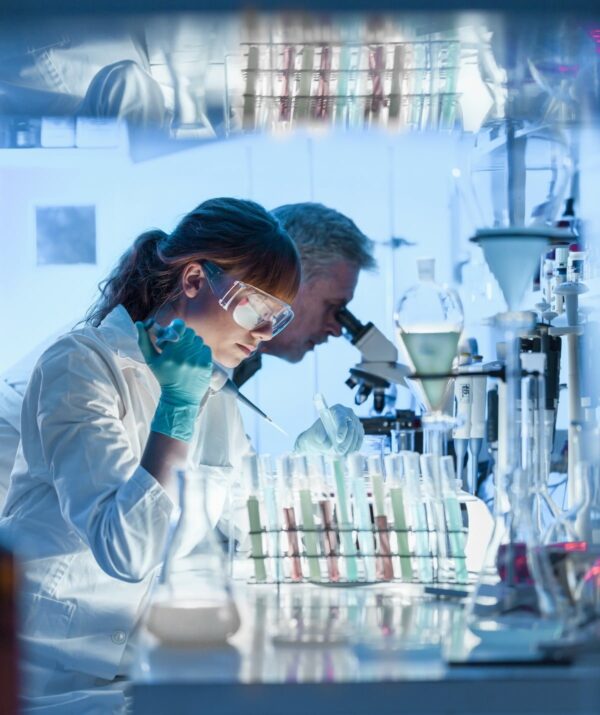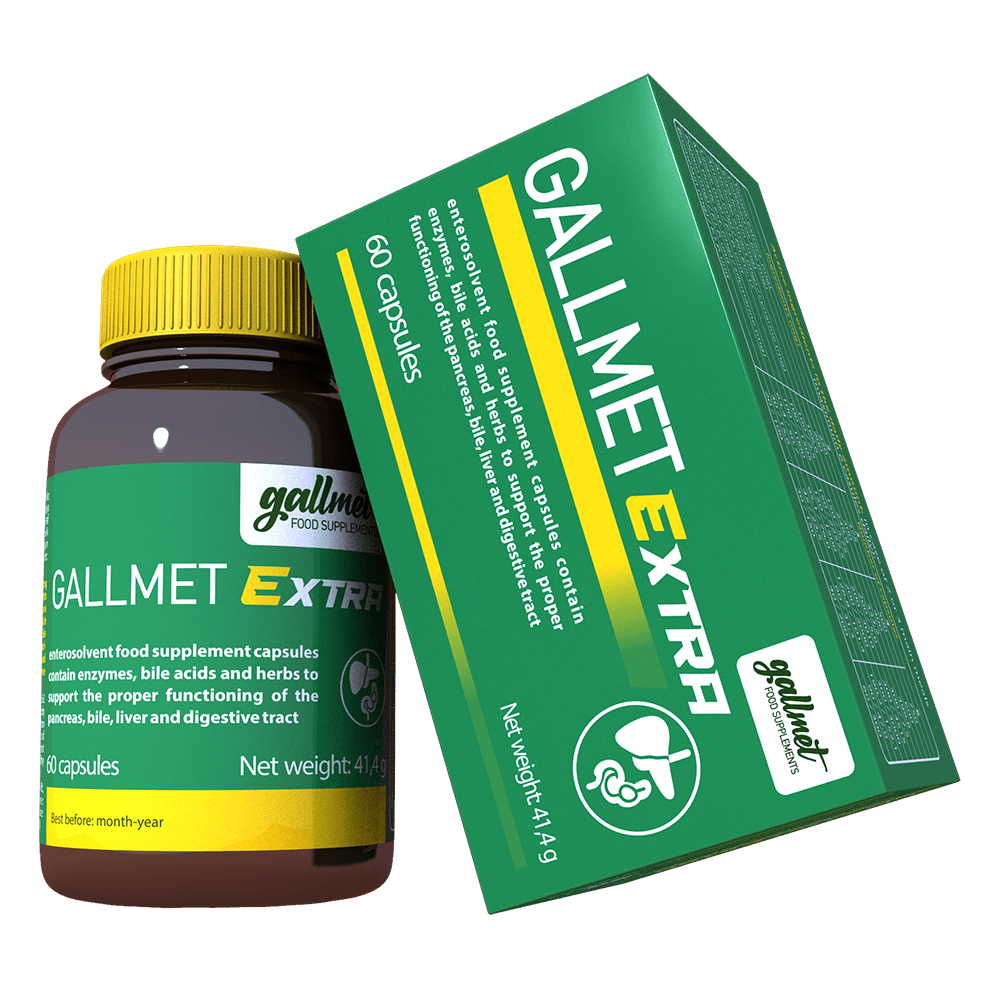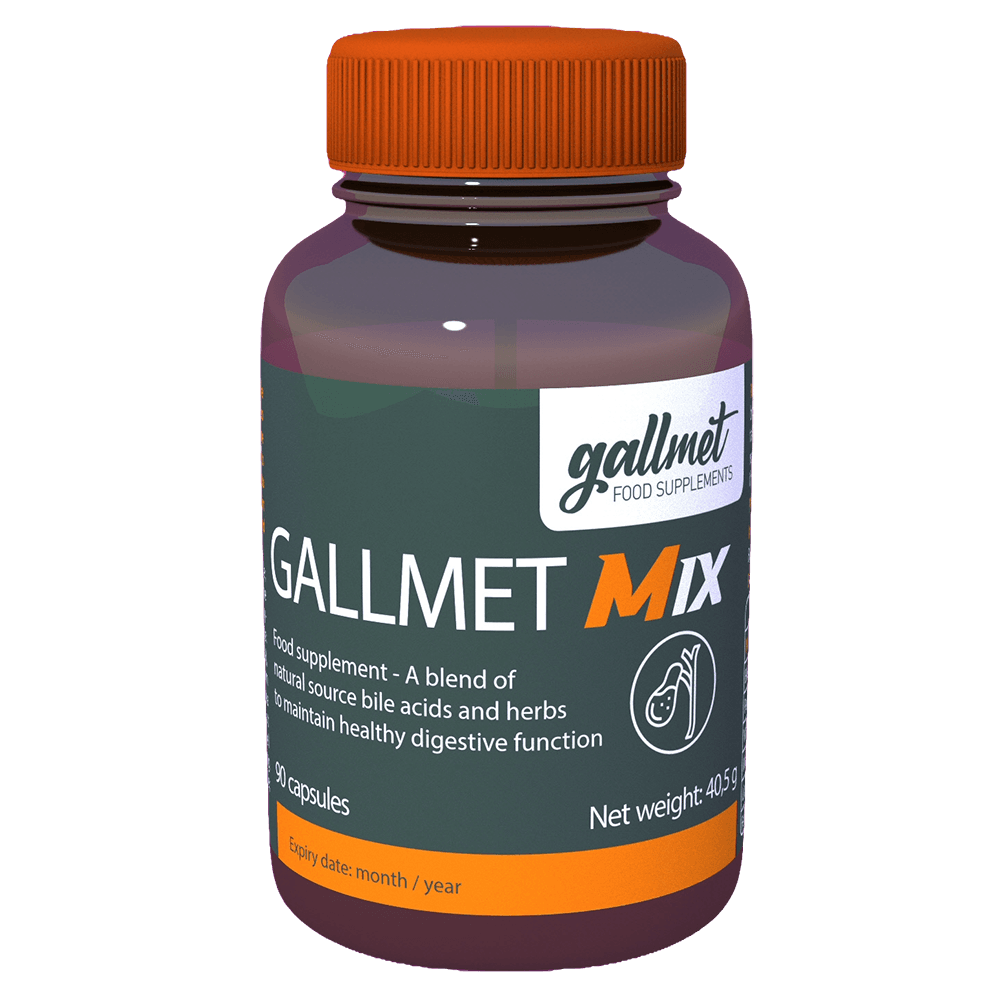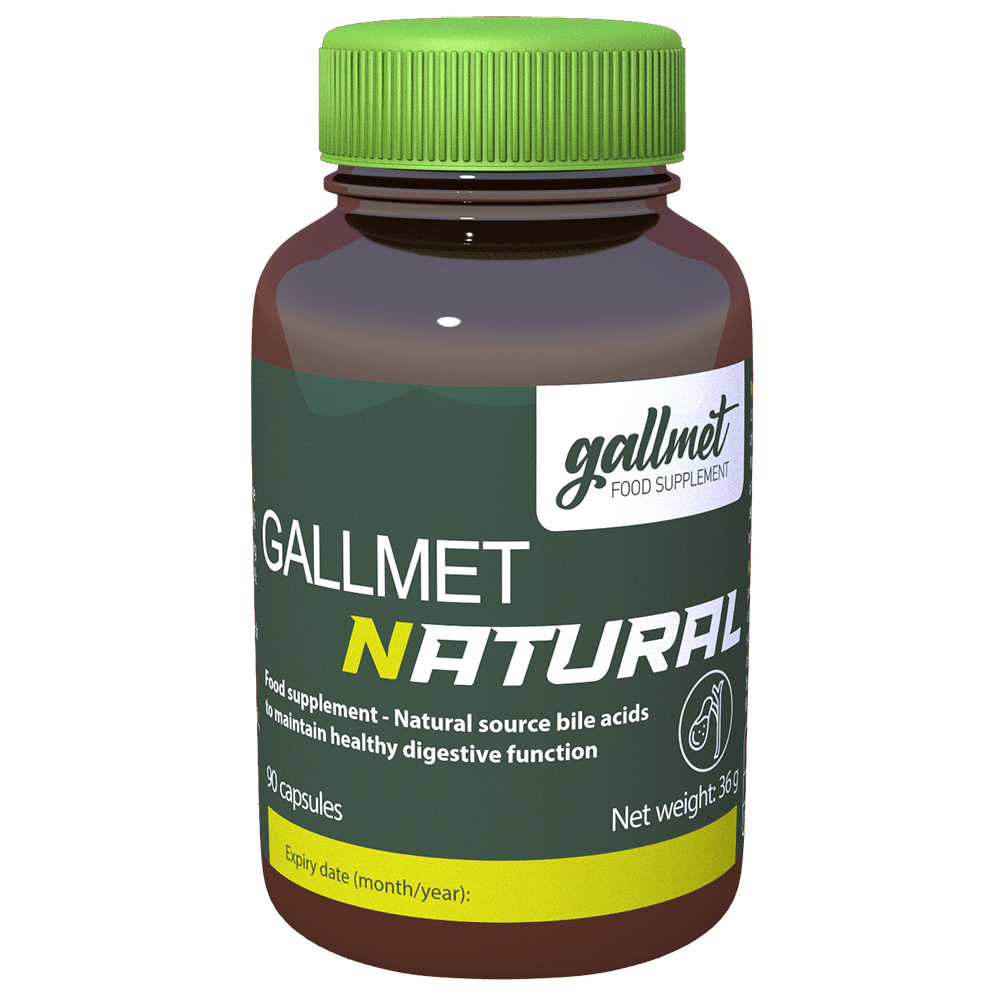GALLMET-Natural and Mix product information brochures, leaflet and laboratory test
Laboratory test results of GALLMET bile acid capsules

GALLMET products have been tested by the international WESSLING laboratory for:
- Microbiology
- pollutants,
- heavy metals,
- radioactivity,
- doping-free,
- does not contain potency enhancing substances,
- allergen-free (gluten, lactose, casein)
Laboratory test results (.pdf):
The importance and physiological effects of natural bile acids in the scientific literature1
(the full text of the quotations and excerpts below can be found in the literature cited here)
The purpose of this leaflet is to provide consumers with adequate and complete information and to help them make an informed and informed choice by outlining the literature on the physiological effects of bile acids.
This information has been prepared in full compliance with the general provisions of Directive 2011/83/EU of the European Parliament and of the Council on consumer protection, the provisions of Directive 2002/46/EC of the European Parliament and of the Council on the labelling of foodstuffs and Directive 2005/29/EC of the European Parliament and of the Council prohibiting unfair business-to-consumer commercial practices, bearing in mind the aim of the legislation to provide consumers with the fullest and most detailed information possible about the product they are buying and its ingredients.
The information on the ingredients of the product is of an informative nature and does not refer to the effects of the product. If you have any health problems, consult your doctor.
1. THE ROLE OF BILE ACIDS IN DIGESTION AND THEIR DEFICIENCY AFTER GALLBLADDER SURGERY
The liver is a structurally and functionally integral part of the digestive system, the bile ducts and gallbladder, the duodenum and the pancreas. These organs interact closely with each other, and their coordinated cooperation is necessary for perfect digestion.
In the mouth, we chew the food into small pieces with our teeth. The sight and smell of food, and even more so its taste, triggers the production of saliva, gastric and digestive juices and some bile.
The movements of the stomach mix the food and then the stomach starts to "push" it out into the duodenum in small portions with great force.
The mechanical or chemical action of food and drink in the duodenum causes more and more, cholecystokinin, which controls gallbladder emptying (gastrointestinal hormone, simply gut hormone) is released and that is: on the one hand opens the joint sphincter of the common bile duct and pancreatic duct; on the other hand constricts the gallbladder, causing bile and faeces to flow into the duodenum (duodenum), where it mixes with the food pulp that reaches it; and thirdly, it stimulates the pancreas to work more efficiently, resulting in a large increase in the production of digestive enzymes.
The intestinal hormone (cholecystokinin) is produced in the lining of the duodenum and is triggered by food and drink (mainly fats and oils) that reaches the duodenum, causing bile is secreted. If bile production, bile excretion, bile flow, bile cycle of bile acids is not appropriate, the breakdown of fats and digestion will be inadequate (bile deficiency, which is typical of at least 25% in humans), which may be accompanied by constipation, bloating, malaise or diarrhoea. This can be favourably influenced by the intake of bile acids with meals.
After gallbladder surgery (postcholecystectomy) the gallbladder's storage function is lost. The bile constantly drips into the duodenum, so in the case of higher bile demand (higher fat meals), there is no bile reserve due to the absence of a gallbladder. So fats are not fully digested and when it enters the large intestine, it breaks down the undigested parts of the intestinal flora, causing abdominal bloating and possibly diarrhoea. Due to the absence of a gallbladder, the occasional bile deficiency associated with meals can be favourably influenced by the administration of bile acids.
2. PSORIASIS.
Role of bile acids and endotoxins in the pathogenesis and treatment of psoriasis (endotoxin = internal poison)2
"On the basis of clinical signs (indigestion, gallbladder lesions, etc.), the authors assume that lack of bile acids may be important in the development of psoriasis. Bile acids are the (physico-chemical) depositories of protection against bacterial endotoxins produced in the intestine, and in their absence, the absorption (translocation) of endotoxins becomes possible, which can cause the release of cytokines. If bile acid supplementation is used to prevent endotoxin translocation, the release of cytokines that trigger inflammation can be inhibited."
3. NATURAL IMMUNITY.
"The role of bile acids in the physico-chemical defence of the body3,4. From bile acids regulate immunity, bile acids are the main determinant of immunity, according to recent international research.5
"The important effect of bile acids, which we have recognised and which has since been confirmed by others, is to protect the body in a special way - in the gut.
A US research team (in vitro) has shown that treating the endotoxin macromolecule with a bile acid (sodium deoxycholate) produces non-toxic "subunits" of lower molecular weight. This has raised the suspicion that bile acids may also be involved in endotoxin detoxification in the living organism (gut).
Bacterial endotoxin is chemically a lipopolysaccharide macromolecule in which the toxic effect is linked to its fatty acid-rich lipid envelope. Thus, it might be thought that endotoxins in living (in vivo), the presence of sufficient amounts of bile or bile acids in the intestinal tract is necessary for detoxification.
This defence mechanism has been called the physico-chemical defence of the body. The basis of the physico-chemical defence is therefore the detergent (emulsifier) action of bile acids.
This raises the question of whether the detergent effect of bile acids is directed only against bacterial endotoxins. Indeed, Max Theiler is known to have observed that the yellow fever virus and other "athropod borne" viruses (taxonomically currently in the Flaviviridae family) are inactivated when combined with monkey bile.
It seems likely that temporary and partial bile acid deficiency can be important, for example in the development of herpes infections, after major nutritional overloads (e.g. weddings, fatty foods at christenings, etc.)."
"About bile acids: physico-chemical protection6.
Understanding the effects of LPS (lipopolysaccharide ~ endotoxin ~ internal poison), an important question has become how it enters the bloodstream. In studying this, in 1969, it was established that the absorption of endotoxins from the gut (translocation) caused by a lack of bile acid. Under natural conditions - in certain pathological cases - endotoxin is always absorbed from the gut into the circulation and triggers pathological processes. Under natural conditions, bile acids protect the body against the endotoxins that are always present in the gut, because they are broken down into non-toxic parts. It also turns out that this protection also protects against all pathogens with a lipoid (lipoproteid) structure (e.g. large viruses with peplon envelopes). This protection system, based on the surfactant (detergent) action of bile acids, has been called physico-chemical protection (Bertók, 2002). Weaker or stronger endotoxaemia due to bile deficiency may play a role in the development of several diseases, such as septic shock, renal failure in patients with jaundice due to bile duct obstruction, intestinal ischaemia, burn shock, radiation sickness, some endocrine diseases, psoriasis, atherosclerosis, etc. Bile acids may play an important role in supporting the human body in protecting against certain diseases (e.g. kidney failure, psoriasis). It has been shown that all the effects that damage the intestinal mucosa reduce or completely eliminate the production of cholecystokinin, in the absence of which the gallbladder cannot excrete bile into the intestine, and in its partial absence endotoxins released from the dead cell wall of the disintegrated Gram-negative bacteria can be "absorbed" and endotoxemicity can occur in the circulation, a wide variety of diseases and, in more severe cases, shock.
The study of the physico-chemical protection based on the surfactant properties of bile acids, and the exploration of its details using modern methods, could be the basis for a new pathological approach, since also touches on fundamental issues of cholesterol metabolism, as bile acids are largely recycled end products of this process. Since all steranase hormones are only a fraction of the bile acids produced, it is reasonable to assume that cholesterol bile acid conversion can largely determine the production and degradation of all the steranase hormones that are important for natural resistance but also for acquired immunity (Bertók, 2002).
It can therefore be concluded that the physico-chemical defence based on the detergent action of bile acids is a general defence mechanism of the organism that is not limited to bacterial endotoxins but extends to all "agents" (e.g. some viruses) with a lipoprotein or lipoid (peplon) structure on their surface. In addition to the known defence mechanisms of the body, we can therefore add the body's physico-chemical defence system, which is ensured by bile acids produced in the liver and involved in the intestinal-liver circulation."
4. The negative effect of stress on bile production and bile excretion can be counteracted by bile acids7
"So stress is a characteristic set of symptoms that is the body's response to any stressor (physical or emotional), particularly in women with more sensitive nervous systems.
Thus, it is now clear and accepted that the Selye's general adaptation syndrome in humans and higher animals is identical to a highly complex defence emergency response, often manifesting as febrile illness, and that this is now acute phase response (AFV) we call it.
The best experimental model of the acute phase response (APR), although not identical in all respects to stress, is the symptom complex induced by a lipopolysaccharide-like endotoxin in the cell wall of a Gram-negative bacterium.
The role of CRP (C-reactive protein) in AFV is therefore also an important component in the development of so-called "immunocompetence". It cannot be ignored that stress has a significant effect on the whole digestive system, including bile production/void. Disturbance of bile production and excretion reduces or suspends one of the body's very important defence systems, the so-called detergent defence system based on the surfactant action of bile acids. In its absence, the body is defenceless against the attack ("translocation") of certain toxins (e.g. endotoxins) and so-called "big viruses" (e.g. herpes group) in the gut."
Based on recent international research and scientific literature, it also includes viruses such as: inluenza, rotavirus, hepatitis B/C/D virus family.5
5. Herpes and bile acids8
Bile acids may be effective against peplon (lipid, lipoprotein) enveloped macroviruses, according to recent international research.5
"The bile secreted by the liver goes into the small intestine, but not all of it and not immediately. The gall bladder, located under the liver, stores a lot of bile, which is emptied after meals, helping to maintain bile production, which means that most bile enters the small intestine when it is needed most.
People who no longer have a gallbladder because it has been surgically removed can no longer rely on this help, so they have a relative bile acid deficiency at mealtimes. They can do something about this by eating more often and in small portions or by replacing the missing bile acid with an appropriate product.
From one of the causes of cold sores may be relative bile acid deficiency.
Based on recent international research and scientific literature, it also includes viruses such as: inluenza, rotavirus, hepatitis B/C/D virus family.5
6. The cholesterol question: too high or too low cholesterol?9
"A large group of compounds formed from cholesterol are bile acids form. They are produced by the liver and, in addition to their role in the digestion and absorption of fats, they are an important means of detoxification, being the only possible physiological pathway for cholesterol excretion.
The role of optimal bile acid production is therefore of central importance, because low bile acid secretion can be the source of many diseases.
Their primary role is to help the body get rid of excess and therefore harmful cholesterol. When the liver produces and secretes less bile acid - caused by stagnant bile that is not secreted properly and regularly - due to eating less food that stimulates bile production, less bile is produced. This leaves more excess cholesterol in the body, the digestion of fats becomes imperfect, and the resulting absorbed fats raise blood cholesterol and triglyceride levels, depositing on the walls of blood vessels in the circulatory system, constricting their inner lumen and creating catastrophic circulatory and heart attack situations.
Some of the bile acids that enter the intestine are reabsorbed, allowing the absorption of fat-soluble vitamins. The bile acids, which also circulate in the blood, help to transport the vitamins to their final destination, the cells. In fact, they allow vitamins to pass through the double (fat and protein) layer of the cell wall to their destination, the cells.
Consequently, if there are not enough bile acid molecules in the gut, i.e. if we do not consume enough bile-secreting foods (e.g. fat, oil), the absorption and use of fat-soluble vitamins (A, D, E, K) is impaired. Therefore, even if we consume sufficient amounts of fat-soluble vitamins, they are not absorbed because of their poor utilisation and deficiencies can occur despite an apparently adequate supply of vitamins.
Two thirds of the bile acids that enter the intestine are reabsorbed into the blood and then enter the liver, where they participate in the gut-blood-liver-intestinal cycle, thus fulfilling their physiological functions.
If the gallbladder is not regularly emptied, digestion becomes incomplete, which affects not only fats but also carbohydrates and proteins, because less secretions containing digestive enzymes are also excreted from the pancreas and pass irregularly into the duodenum. Stagnant bile can trigger stone formation and bile spillage into the pancreas can trigger gland inflammation with all its unforeseen unpleasant consequences.
Irregular bile excretion has many other harmful consequences:
- Under normal conditions, bile acids destroy harmful bacteria from the pharyngeal microflora that enter the small intestine during reduced gastric acid production, which without e would have a putrefactive, gas-forming effect,
- may cause bloating, wind cramps and possibly diarrhoea. The small intestine is normally sterile, bacteria have no business there!
- Bile acids that pass down into the last part of the small intestine are the main factor in triggering the normal defecation stimulus. Consequently, if little bile acid enters the small intestine, i.e. if concentrated bile is not regularly emptied from the bladder on a daily basis, constipation may occur. First, the daily bowel movements are not carried out, and more water and toxic substances are absorbed from the stagnant faeces, which poison the body (autointoxication), the normally formed stool becomes hard and lumpy. The bile dye in the more concentrated bile turns the stool dark brown. The darker or lighter colour of the stool is an accurate indicator of the amount of bile dye that has been excreted.
- Bile acids can also destroy viruses with an outer protein coat (peplone) in the colon. They destroy, deactivate and disperse endotoxins of the bacterial flora living there. Endotoxins (internal toxins) are allergic due to their large molecules, can cause cardiac arrhythmias, fever, general intoxication (sepsis) after surgery, and can contribute to male infertility.
Bile acids therefore play an important role in warding off adverse effects on the body's physical and physiological condition."
7. THE ROLE OF FAT PROCESSING IN DISEASE.
"Bile acid circulation is involved in all diseases to a greater or lesser extent10
During eight years of research, Dr Péter Légrády and the team of doctors he set up have come up with a new approach and a new result. They investigated the circulation, metabolism and obstruction of bile and bile acids, which are important in the circulation of fat, fat-like substances and fat-soluble substances, or in simple terms: the dysfunction of the liver and bile system. In other words, not only liver and biliary diseases (e.g. biliary tissue), but also diseases that are thought to result from or to play a greater or lesser role in the dysfunction of this system, such as rheumatic diseases, migraine, functional infertility. Biliary headaches are common: migraine biliare.
Allergic diseases have also been studied and researched, and the role of the hepatic biliary system in some or many long-standing chronic diseases, both in their development and in their curability. This novel, different approach.
There can be five to six to seven sites of bile acid metabolism failure. It depends - which one - on which treatment is needed.
Two thousand patients have been examined, which is five thousand cases including controls. Their eight years of work have shown that the circulation of fat-like and fat-soluble substances is more or less involved in all diseases. And a key part of this is the turnover of bile acids. If the normal ratio can be adjusted, patients will improve."
8. CANDIDA Albicans (candidiasis).
"Candidiasis: real danger or big business? 11The candida albicans a sprouting, forming pseudo-twines yeast species, which is found in the mucous membranes, skin and intestinal tract of healthy people. Candida yeasts are as involved in the utilisation of decomposition products in the body as other gut-dwelling microbial species... candidiasis is usually triggered when certain environmental factors (e.g. antibiotics, inappropriate diet, irregularity, stress) reduce intestinal immunity, which can lead to the growth of Candida fungi... Candida albicans from several pages and in a comprehensive way across our organs attacks. If the Candida fungi have started to multiply in the intestinal tract, in the genital and urinary tract cavities, on the skin and in the mouth, the perforation of the intestinal wall mucosa next. In this case, the fungi can be absorbed and enter the circulatory system, causing a condition known as "fungal infection". systemic (body-wide) candidiasis... All these conditions are often fulfilled in "modern" people with a general lifestyle, so that fungal diseases may have become a widespread disease... general health is more compromised than ever... Prolonged use of broad-spectrum antibiotics or some antibiotics (penicillin, tetracycline, erythromycin) may damage the delicate microbial balance of the gut flora. The in products of animal origin (milk, dairy products, meat) may also contain antibiotics... A diet low in cellulose and pectin (fibre), combined with an excess of protein and fat, increases the risk of candidiasis... The effects of stress on the intestinal tract and central immunity are now widely known, which is why it is extremely important to achieve mental calm and equilibrium in order to improve the patient's condition... There are several points of correlation between candidiasis and allergic diseases. The immune system, weakened by allergies, becomes extremely vulnerable and can easily become a target for fungi... Many cases of systemic fungal disease underlying allergies are systemic and the incidence of allergic rhinitis (hay fever), asthma, eczema and food allergies among people with candidiasis increases dramatically... Prolonged exposure to fungi makes the immune system hypersensitive to the invading cells, cellular substances and metabolites, resulting in chronic allergic symptoms... Some of the allergic symptoms are not caused by living fungal cells but by the chemicals they secrete and the fungal cells they kill..."
"What you need to know about candidiasis.12 Candidiasis can be a severe systemic (affecting the whole body) disease, which develops in certain clinical situations or in the presence of predisposing factors... Systemic candidiasis is a serious, life-threatening disease that develops in patients with reduced immunity or after major abdominal surgery, in patients in intensive care units, following surgical procedures... Some of the well-known pathologies affect the skin and skin appendages, others the mucous membranes. More surgical or systemic candidiasis is being detected than in the past, as the number of patients with reduced immunity is increasing. Amongst organ and bone marrow transplant recipients, patients with malignant haematological disease undergoing aggressive chemotherapy, intensive care unit patients, patients with long-term intravascular cannulae, patients undergoing major abdominal surgery, HIV positive patients, the emergence of candidiasis and other mycoses is a major challenge. Vaginal candidiasis can recur in women with intact immunity, even in the absence of predisposing factors... As a pathology, "new" candidiasis, which is organism-wide, is associated with a wide range of symptoms and complaints. Itching of different parts of the body, visual impairment, fungal bleeding in the throat, nasal congestion, fatigue, lack of concentration, abdominal distention, carbohydrate hunger, tightness, diarrhoea, menstrual cramps, etc. Some patients have or have had skin, nail or vaginal candidiasis or other fungal processes... Patients with 'new' candidiasis do suffer. The patients' malaise and abdominal complaints may be due to colon disease, irritable colon, or tumours."
"Nowadays, the importance of fungal infections has increased with the rise in the number of patients with temporary or persistent immune deficiencies.13 Granulocytes and monocytes play a crucial role in the defence against fungal infections, so patients with a deficiency of white blood cells that provide resistance to fungal infections (neutropenia) can develop severe, system-wide infections. More than 50% of the deaths of cancer patients during their period of white blood cell deficiency with resistance to fungal infections are due to systemic fungal infections, according to autopsy studies (Jehn 1988). In patients with white blood cell deficiency providing resistance to fungal infections, system-wide fungal infections often result in death despite antifungal therapy... It is not unimportant how the drugs used cause further damage to the already depressed bone marrow..."
"The antifungal role of bile acids:15 It is now established that bile acids and their simple derivatives show anti-Candida activity... In the light of the foregoing, it was a surprise to discover that bile acids have an anti-proliferative effect on Candida fungi..."
"Environmental biology of Candida albicans colonization in the intestine:16 The stomachs of antibiotic-treated and untreated Syrian hamsters were inoculated with Candida albicans to determine whether the Candida fungus can colonise the gastrointestinal tract and spread to the visceral organs in an adaptive manner. The gut microflora, impaired by antibiotic treatment, predisposed hamsters to overgrowth of Candida albicans in the gastrointestinal tract and to systemic spreading in the 86% of the animals... Our results clearly demonstrate the importance of normal, healthy gut microflora in inhibiting the ability of Candida albicans to colonise and spread... Secondary bile acids can reduce the attachment of Candida albicans to the mucosa, by altering Candida adhesin molecules or mucosal receptors or both, thus making it impossible for Candida cells to attach to intestinal tissues."
9. HEALTH-METABOLISM-DIABETESIS. Is the bile the source of youth?17,18
Science has taken another step forward in the search for longevity. A new study from Concordia University in Canada is the first to identify the role of a secondary bile acid, litocholic acid (LCA), in extending lifespan.
The research was carried out with yeast fungi, but the discovery could have significant implications for human lifespan and health, as yeast fungi share many of the same elements as humans."
"We know from previous studies that bile acids are beneficial for health and longevity. For example, they have been shown to accumulate in the bile of blood of aged mice and play a role in improving liver and pancreatic function in rodents. In light of these findings, we believe bile acids have the potential to treat diseases associated with advancing age. They may offer hope for a healthy old age."
1 G.A.D. Haslewood (Emiritus Professor of Biochemistry in the University of London) : The Biological Importance of Bile Salts, 1978, North-Holland Research Monographs Frontiers of Biology - Volume 47., ISBN 0-7204-0662-5.
2 Dr Bertók Lóránd (Doctor of Medicine - Hungarian Academy of Sciences, Professor Emeritus, He is in 500 Greatest Genuises Of the 21st Century - American Biographical Institute) and Dr Gyurkovics Klára: Role of bile acids and endotoxins in the pathogenesis and treatment of psoriasis, http://www.vitalitas.hu/olvasosarok/online/oh/2000/17/5.htm
3 Dr Lóránd Bertók (Doctor of Medicine - Hungarian Academy of Sciences, Professor, He is in 500 Greatest Genuises Of the 21st Century - American Biographical Institute): The role of bile acids in the physico-chemical defence of the body, Hungarian Science, 2008/07, page 844
4 Dr Bertók Lóránd (He is in 500 Greatest Genuises Of the 21st Century - American Biographical Institute), Dr Berczi István: Natural Immune Mechanisms and of Species Specific Resistance, Advances in Neuroimmune Biology 1 (2011) 11-24, DOI 10.3233/NIB-2011-002, IOS Pres
5 Antiviral and immune supporting effects of bile acids https://www.epesavak.hu/virus-immun-szakirodalom
6 Dr Lóránd Bertók (Doctor of Medicine - Hungarian Academy of Sciences, Professor, He is in 500 Greatest Genuises Of the 21st Century - American Biographical Institute): The role of endotoxins in natural immunity, Hungarian Science, 2004/10, page 1130.
7 Dr Lóránd Bertók (Doctor of Medicine - Hungarian Academy of Sciences, Professor, He is in 500 Greatest Genuises Of the 21st Century - American Biographical Institute): New aspects in the pathophysiology of stress - In memory of Selye, Hungarian Science, 2007/05, page 607
8 Dr Tihanyi: Detoxification, http://bolthely.hu/drtihanyi/oldal/egyeniu0026amp;id=4a4a7836362b0f5_Meregtelenites
9 Dr Tibor Gere: The cholesterol question: too much or too little, http://www.termeszetgyogyaszat-1.eoldal.hu/cikkek/a-koleszterin-problemarol/a-koleszterin-problemarol
10 Dr. Péter Légrády: Bile acids and cholesterol, Heti Patika, 1992.03.17.
11 Gábor Tóth: Allergy and Candida guide, Pilis-Vet Bt., 2005, ISBN 963 214 184 9
12 Dr Gyula Princz (Szent László Hospital of Budapest): What you need to know about candidiasis, MEDICINA 2000 VI Conference on Outpatient Specialist Care, Clinical Bulletins, IME Volume III No. 10 January 2005
13 Dr Ilona Benkő: Effect of antifungal azole derivatives and cytokines on normal and abnormal haematopoietic colony-forming cells, PhD thesis, Debrecen, 2001
14 SUSAN E. MARSHALL, B. A. MARPLES, W. G. SALT and R. J. STRETTON: Aspects of the effect of bile salts on Candida albicans, Journal of Medical and Veterinary Mycology (1987) 25, 307-318.
15 Marples; Brian A., Stretton; Reginald J.: Antifungal utility of bile acids, U.S. Patent Documents: 4164573; 4434159; 4440688; 4579730, Foreign Patent Documents: 683192; 848333; 1430324; 1563311; 1601613; 2116036A.
16 MICHAEL J. KENNEDY and PAUL A. VOLZ: Ecology of candida albicans Gut colonisation, INFECTION AND IMMUNITY, Sept. 1985, p. 654-663, American Society for Microbiology.
17 Richard Balázs: Bile is the source of youth?, 16/09/2010, http://www.sg.hu/cikkek/77024/az_epeben_keresendo_a_fiatalsag_forrasa
18 Bile acids may be beneficial to health, http://www.sciencedaily.com/releases/2010/09/100915100935.htm
This compilation was reviewed by an international law firm and checked the following main aspects: food safety, advertising and trade of food supplements, consumer protection, relevant EU legislation.








